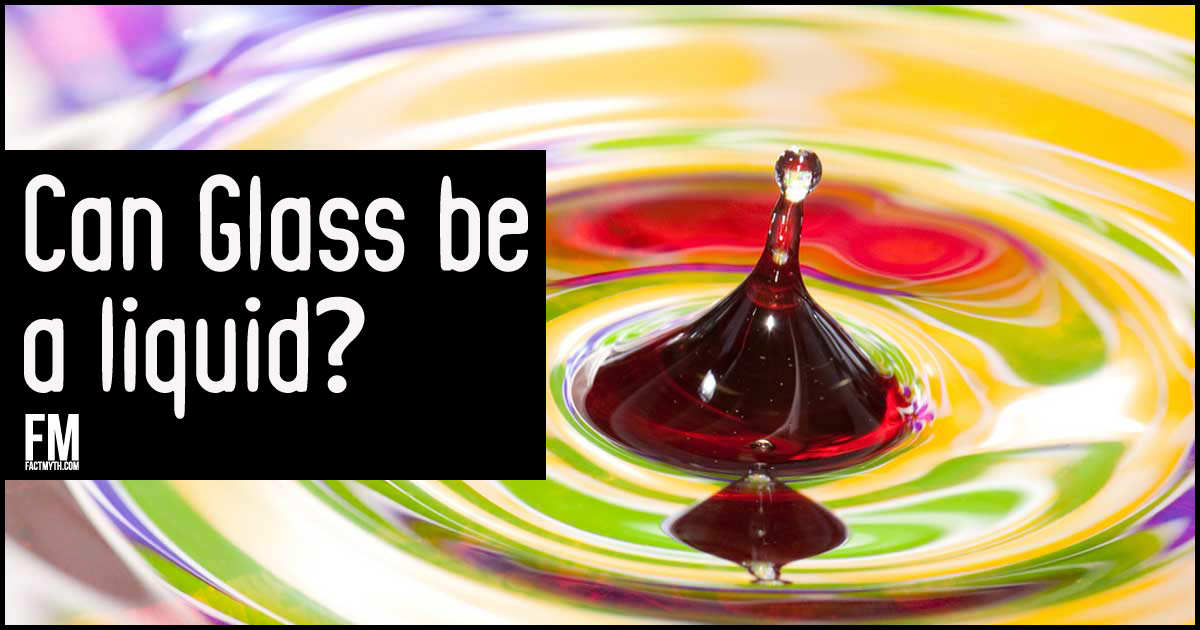Glass isn’t a liquid and old glass windows don’t flow over time. Glass is likely best described as an amorphous solid, or… just “glass”, but further studies may uncover more.
Glass Can Be a Liquid myth

Is Glass a Liquid or a Solid?
Glass, in any form, is not a liquid or a supercooled liquid, and it does not “flow” in its solid state. Glass is considered an amorphous solid, or just “glass.”
Is Glass a Liquid? Veritasium explains the nature of glass and takes a look at the old “glass flows in old windows myth.”What is Glass?
Glass is perhaps best described as an amorphous solid. It is a state of matter that is neither liquid nor solid. We know enough about glass to know that it is not a liquid, but we still don’t fully understand its molecules and transition states, so more information could be unveiled. Given this, we can’t entirely confirm “what glass is” in all its states, only that it doesn’t meet the definition of “liquid” in any known state.
Does Glass in Old Windows Become Thicker on the Bottom?
We know that glass can be a liquid-like in a heated state (although not a true liquid), but does window glass retain some viscous characteristics and flow to the bottom of the window pane over time in its solid state?
Does Glass Flow?
Glass doesn’t flow to the bottom of old windows over time in it’s solid state; glass only “flows” if heated to high enough temperatures. This is true even though we may see uneven old glass windows.
Many of us look at old stained glass windows as well as the windows of ancient houses and see uneven panes of glass showing noticeable differences in thickness. These panes are thicker at the bottom than the top or are otherwise irregular.
We know glass isn’t flowing, but let’s ask some scientific questions to try to find out what IS happening.
First, the most obvious question: If old windows have glass that flows until it becomes thicker at the bottom, wouldn’t very old Hellenistic or Roman glass bowls, ancient telescope lenses, and ancient glass vessels also become thicker at the bottom?
Answer: Naturally, but we see no evidence of flow in older glass artifacts.
Second: If the glass in old stained glass windows flowed, wouldn’t the “lead came” (which holds the glass) flow even more quickly since lead is roughly a billion times more viscous that solid glass?[1]
Answer: Naturally, but this doesn’t happen either.
Is Glass a Supercooled Liquid?
Some have claimed that glass is a supercooled liquid because it can stay liquid-like instead of crystallizing when cooled. However, glass doesn’t have the molecular structure or transitional qualities of a supercooled liquid. Namely, it has a “second order phase transition” between the supercooled liquid state and the solid state, and a rigid molecular structure in all states that does not “flow” and splash like a true liquid or a supercooled liquid.
For a scientific explanation check out, “the University of California Riverside’s Department of Mathematics explainer of “is glass a liquid or solid.”
Does Glass Flow Because it is a Supercooled Liquid?
I have heard Science teachers assert with high authority that old cathedral windows are melting over time because glass is a supercooled liquid which appears solid.[2]
This is not true; glass doesn’t flow, and it is also not a supercooled liquid. For glass to be that fluid, it would have to be hot.
For new findings on glass as a liquid see this study, “Using 20-million-year-old amber to test the super-Arrhenius behaviour of glass-forming systems.”
Other Materials that are Both Liquid and Solid
Some materials are a confusing mixture of solid and liquid, but glass is not one of them.
Polymers like Silly Putty and substances like Pine Sap appear to be solid, but are viscous and flow because of their weight. Metals like copper lead have plasticity and deform slowly under stress. Many polymers and some other materials (mercury for instance) make classification complicated because they have properties of both liquids and solids.

Source: antidigerati via Flickr.com.
What Kind of Material is Glass?
There are many different types of glass. Do some flow while others don’t? Do only some turn to supercooled liquids?
Different builds of glasses have different properties, but in all cases, the best way to classify glass is probably as an amorphous solid.[3]
Glass can be made of silica, which becomes liquid at 1200° C. You can have a modern soda-lime glass, which has a transition about 550° C. Some glasses such as Pyrex have a higher melting point while others such as those based on silicates have a lower point.
Glass is not liquid-like at ordinary temperatures and does not flow in its stable state. It is an amorphous solid that takes on some liquid-like characteristics, but only at high temperatures.[4]
- “Does Glass Flow?” Cmog.org
- “Fact or Fiction?: Glass Is a (Supercooled) Liquid” Scientificamerican.com
- “Complex Systems: Amorphous Materials” Ucsb.edu
- “Amorphous solid” Wikipedia.org
